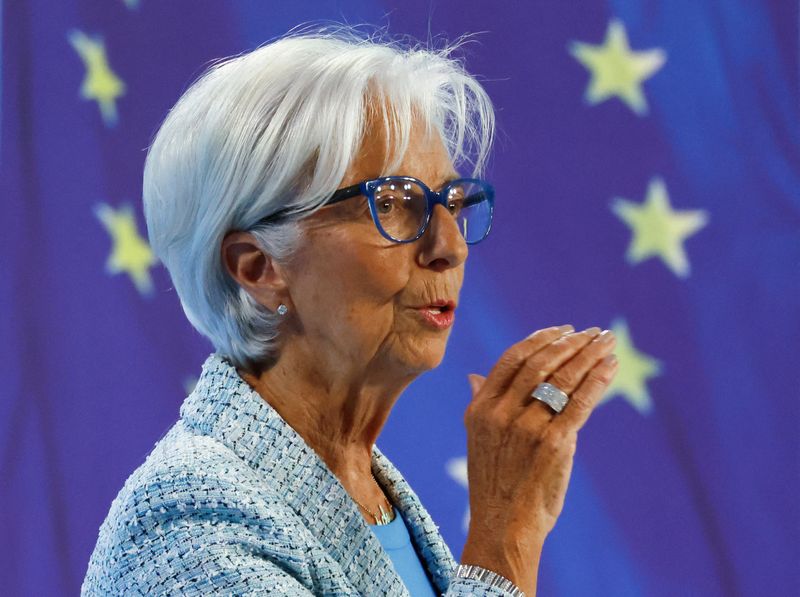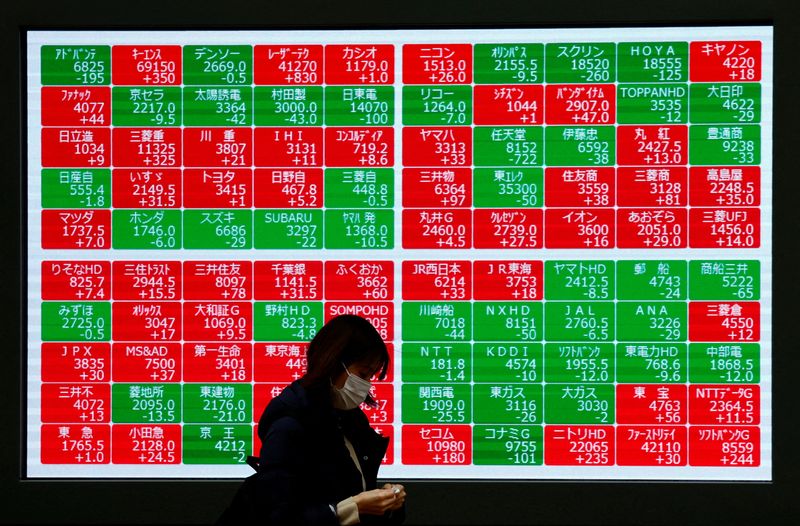By Marc Jones and Koh Gui Qing
NEW YORK/LONDON (Reuters) -World stocks climbed and the euro rose on Thursday after the European Central Bank cut interest rates for the first time in nearly five years, while signaling that further moves could take a while.
ECB policymakers delivered their widely flagged quarter-point cut to 3.75%. The euro and German government bond yields rose after the ECB move as investors took into account the central bank's refusal to promise further rate cuts.
The euro inched up to almost $1.0890 against the dollar and government bond yields - which reflect borrowing costs and move inversely to price - ticked up too.
The pan-European STOXX 600 rose 0.7%.
MSCI's 47-country main world index rose as much as 0.3%, near a record-high set on May 20, before trimming gains slightly.
Wall Street, however, was more muted, with the S&P 500 index unchanged after hitting an all-time high earlier on Thursday. The Dow Jones Industrial Average rose 0.2%, and the Nasdaq Composite Index was flat, also pulling back from an all-time high hit earlier in the day.
Chip maker Nvidia (NASDAQ:NVDA) fell 1.1% after hitting a record high, a day after crossing $3 trillion in market valuation.
Marchel Alexandrovich, a partner at Saltmarsh Economics, said markets will now focus on whether the U.S. Federal Reserve will cut rates in September.
The euro's gain, after a 2% rise over the last month, took it to $1.0887, although most traders were sitting on their hands. ECB President Christine Lagarde stressed at the start of her post-meeting press conference: "We are not pre-committing to a particular rate path."
Stronger-than-expected data over the last few weeks, plus Thursday's increase in the ECB's in-house inflation forecasts, have raised doubts about how many more rates cuts will be justified this year.
"This was a cautious cut," said Samuel Zief, head of global FX strategy at J.P. Morgan Private Bank. "We currently think that September could be next. But (there is) no reason to expect significant reductions any time soon with growth actually picking up steam of late."
GOLDILOCKS STORY
The Bank of Canada pipped the ECB to become the first G7 country to cut rates in this cycle on Wednesday. The U.S. Federal Reserve meets next week, although is not expected to move until September, at the earliest.
"This move ahead of the Fed was not at all obvious just three months ago," said Eric Vanraes, the head of fixed income at Eric Sturdza Investments. "We still believe that the first rate cut will come before the fourth quarter, in September."
By contrast, the debate at the Bank of Japan, which meets the week after, will be about whether to raise rates, and when.
Canada's dollar trimmed some of the losses from its post-cut dip on Thursday to stand at C$1.37 per U.S. dollar.
In the bond markets, Germany's two-year government bond yield, which is sensitive to policy rate expectations, rose as high as 3.037%. It hit 3.125% on Friday, its highest since mid-November.
Benchmark 10-year U.S. Treasury yields were flat at 4.287%, although that was still near their lowest in two months, after data this week hinted that the U.S. labor market is finally cooling.
The data included private U.S. payrolls on Wednesday and a report on Tuesday that showed job openings fell in April to their lowest in more than three years.
Markets are now pricing nearly two quarter-point Fed cuts again this year, with a September move seen as a 68% chance compared to 47.5% last week.
"We're still in the 'Goldilocks' range, so bad economic news has been good for equities, as Fed rate cuts are back on the table," said Ben Bennett, Asia-Pacific investment strategist at Legal and General Investment Management.
Investor attention will soon turn to the U.S. nonfarm payroll report for May on Friday, with a Reuters poll of economists expecting payrolls to have risen by 185,000 jobs.
"We need that to be around 100-150k to maintain the Goldilocks narrative," Bennett said. "Much higher than that and yields could move back up, but if we get zero or negative, then we could be talking about a hard landing again."

In commodities, Brent crude futures rose as much as 1.9% to $79.86 a barrel, while U.S. West Texas Intermediate crude futures rose 2% to $75.53. [O/R]
Gold gained 0.8% to $2,372.77 per ounce after a 1% rise previously, while the cryptocurrency bitcoin was at $71,415, shuffling back towards March's record high. [GOL/]
